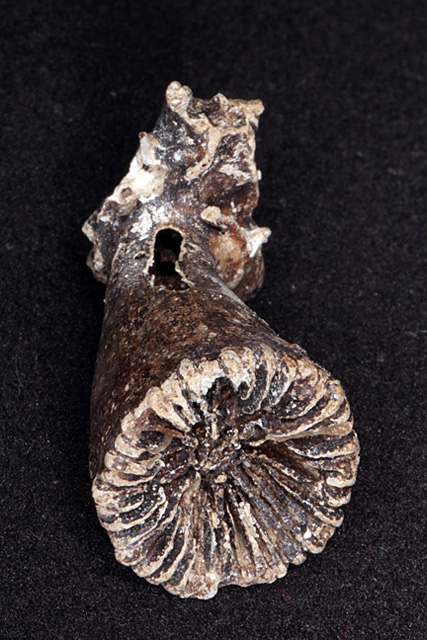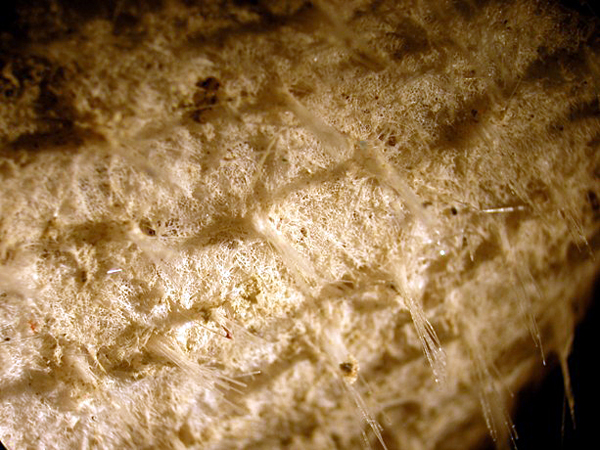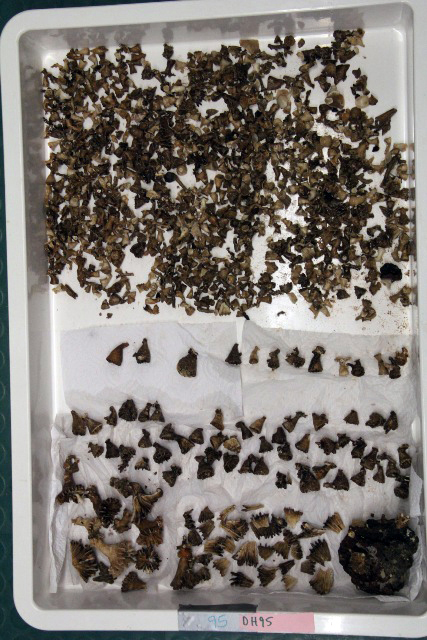Page 2/2 - Posted August 5, 2011
Corals to offer insights into changes in ocean circulation since last ice ageThat accuracy allows them to not only determine what the ocean chemistry was like in the past but exactly when changes occurred. “Using this coral archive is very powerful in that respect,” explained Robinson, an associate scientist at Woods Hole Oceanographic Institution Her team is particularly interested in traveling back in time to the last glacial period, more commonly known as the last ice age, about 20,000 years ago and the transition into a warmer period, the modern Holocene. (Some corals that have been collected in the Drake boast ages hundreds of thousands of years old.) 
Photo Credit: Andrew Margolin
This fossil coral is a Caryophyllia antarctica cup coral collected from Interim Seamount, and will be used for paleoclimate reconstruction.
The transition from glacial to interglacial in the Southern Ocean, as told in the chemistry of the corals, could offer insight into how the ocean and the rest of the climate system respond to such environmental swings. “The more we can understand about how the ocean interacts with the atmosphere, and the timescales of change and the magnitudes of change in all parts of the climate system, the better position we are [in] to say something about changing climate conditions in the future,” Robinson said. Tied to that understanding is ocean circulation and how it responds to climate change. Again, the corals provide clues in the form of carbon-14, a naturally occurring radioactive isotope of carbon that forms in the atmosphere and dissolves into ocean surface waters. Higher carbon-14 content in the coral material means more ocean mixing between the surface and the deep. The longer deep water is isolated from the surface, the less radiocarbon a sample contains. “It’s a powerful way of looking at ocean circulation,” Robinson noted. The dating methods are also important to the biogeographical research, helping the scientists map diversity and distribution of coral populations over time — a unique way of looking at changing ecosystems that may help maybe predict how they will behave in the future. “It’s definitely a puzzle. A species that seems to have been doing well tens to hundreds of thousands of years ago, we only find one or two live ones on these seamounts,” Waller said. Shallow sediment cores from the seafloor, which provide far less time resolution than other methods, are important for mapping this historical distribution and diversity. Bits of coral skeletons embedded in the cores can help pinpoint when corals were growing in certain areas of the past. The vessel traveled more than 5,000 kilometers, visiting the continental slopes of both the Antarctic Peninsula and South America, including infamously stormy Cape Horn. Trips to various seamounts — ancient underwater volcanoes — in the Drake offered an opportunity to collect samples from a variety of depths. “It’s a pretty wild, featureless part of the world, as you look out from the ship,” Robinson said. “But then [you] go down and take photos of the incredible abundance and diversity of life on these seamounts and shelf areas, which is pretty impressive. You already know it, but when you see it, it’s a good reminder of how diverse these seemingly isolated places are.” The 2011 expedition follows an exploratory cruise by Robinson and Waller in 2008 that proved the viability of their collection and photo techniques in the Southern Ocean. Preliminary results from that cruise suggested that geological and environmental variability, particularly in temperature, between six sample sites may influence cold-water coral biogeography. No one area resembled the others in terms of animal diversity. “Very often these cruises come back with more questions than they do answers. It hopefully won’t be the last time we head into the Drake Passage,” Waller said. NSF-funded research in this story: Laura Robinson, Woods Hole Oceanographic Institution, Award No. 0944474, 0902957 |



For USAP Participants |
For The Public |
For Researchers and EducatorsContact UsU.S. National Science FoundationOffice of Polar Programs Geosciences Directorate 2415 Eisenhower Avenue, Suite W7100 Alexandria, VA 22314 Sign up for the NSF Office of Polar Programs newsletter and events. Feedback Form |




